Highs and lows
Mansell finally took a record ninth win in a for Williams-Renault, but politics and Patrese’s accident marred the victory
No 1992 Grand Prix quite so encapsulated Formula One as it now is, than Portugal. Very much, the weekend in Estoril was one of highs and lows.
Since Monza, Nigel Mansell had, of course, made his lndycar bed. The signs in Portugal were that he was more than happy to lie on it. So much so, that one could not help but wonder, as Alain Prost did recently, just when the World Champion-elect really decided enough F1 was enough.
Around the time of the Hungarian GP, when everything was still up for grabs, Mansell would have been on the rev limiter after the first major failure of Williams’ active ride suspension that he experienced on Friday morning. It happened at the end of the back straight, which leads down to the 180 degree lefthander. Fortunately, there was plenty of run-off area, but it clearly shook him, as well it might have. “It was a big, big moment, believe me,” he insisted.
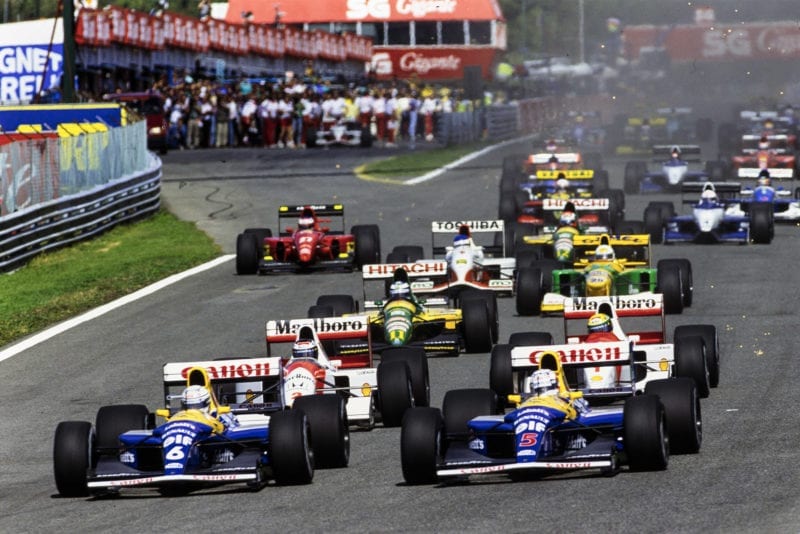
Riccardo Patrese and Nigel Mansell fight for the lead at the start of the race
Motorsport Images
Estoril is one of those circuits that time forgot. You know, the sort of time that in England would insist on safety fencing all round to protect the spectators. Triple layer Armco barrier in strategic locations where, the other side of the current two tiers, lies a steep drop. When he first encountered it testing for McLaren last year, Michael Andretti could not believe it. And this is a man well versed in the fairground nature of Milwaukee’s mile, or Nazareth’s tight oval. It is not the sort of circuit that you want to leave involuntarily, Estoril.
For all that scare, Mansell was on his top form during Friday qualifying when he all but equalled the pole-winning lap Riccardo Patrese had set the previous year with full qualifying tyres. He was relaxed, and cautiously optimistic. In the back of his mind, however, were the niggling little problems that had — and it seemed incredible when you thought about it — kept him away from the victor’s laurels since Hockenheim. Three whole races. The theory at Williams was intriguing. Since Hungary Elf’s fuel has perforce been of different make-up, and Renault believed that the latest product made its V10 run less smoothly. The RS3C could withstand this, but the RS4’s systems, particularly a plastic component in the pump that actuates the active suspension’s hydraulics as well as those of the transmission, were having difficulty. The vibrations lost Mansell an ignition coil in Belgium, and shook off both cars’ hydraulic drive belts in Italy. Now they had upset the pump again. The notorious bumps of the circuit hardly helped, either.
Optimism tempered by such thoughts, Mansell went to the line determined to win on what may be his last European appearance in a motor race. And he dominated throughout. It almost certainly wasn’t, but it looked all the way through as if he was out for a Sunday afternoon drive. The Williams-Renault did not miss a beat, there was no drama in his pit stop which, sensibly, he delayed as long as he dared to cater for changing track conditions. He left with four wheels, and they stayed in place. He didn’t even lose the lead when he came in, since everyone else had already lost time making their calls for fresh Goodyears before he pitted at the end of 29. After the misgivings, his record ninth win in a single season came easily.
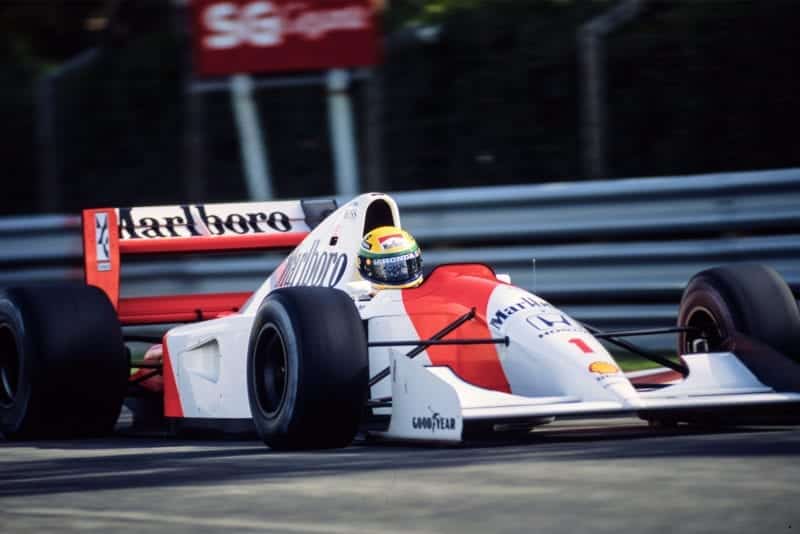
Ayrton Senna in his McLaren. The Brazilian would go on to finish third
Motorsport Images
Behind him, there was a fair degree of mayhem. Most of it concerned team-mate Patrese, who had one of the luckiest escapes we are ever likely to witness. The Italian had, as is the norm, backed Mansell in qualifying without realistically challenging him. And as Mansell pulled away comfortably in the opening stages, so Riccardo had outpaced the bucking McLarens of Senna and Berger. But when a rear wheel retaining nut stuck momentarily during his tyre stop on lap 23, he dropped way back to fifth place, behind not only the McLaren duo, but also Mika Hakkinen’s finely-driven Lotus which temporarily occupied second place during the stops but otherwise ran a solid fifth.
Mile by mile Riccardo hauled in Berger’s MP4/7A (the active MP4/7B might have been better suited to the bumpy course but was not deemed sufficiently reliable after prolonged testing). Thus the stage was set for the appalling incident that befell Patrese on lap 43.
For the previous handful of laps he and Berger had been circulating nose to tail, with Riccardo continually pulling out and drawing alongside, but never quite able to pass. Gerhard certainly knew he was there. Coming through the long, high-G right-hander that leads on to the main straight, the Williams was tucked right in behind the McLaren. As he had done for a couple of laps. Berger eased from the left-hand side of the road on the exit towards the right-hand side to hug the pit wall and, eventually, protect his inside down into the first turn, where overtaking is sometimes possible. At Estoril, that’s saying something. This time, however, Gerhard decided to come late into the pits for another set of tyres, but did so quite without signal. Patrese, fullbore behind him, realised too late that the McLaren was slowing and as his front right tyre hit the MP4/7A’s left rear the Williams was launched into a spectacular climb.
Watching it arc so high that it almost clipped the pedestrian bridge across the straight, was like seeing movie footage of a speedboat flipping, but fortunately the FW14B didn’t quite get to the point where the weight of machinery in its tail acted like a pendulum to drag it through a full somersault. Equally fortunately for Riccardo, although he probably didn’t think so at the time, was that it landed tail first on to a medium that allowed it to keep moving. Gilles Villeneuve had been killed at Zolder because after taking off over the back of Jochen Mass’ March, his Ferrari had dug nose first into soft sand which arrested it very suddenly and broke his neck.
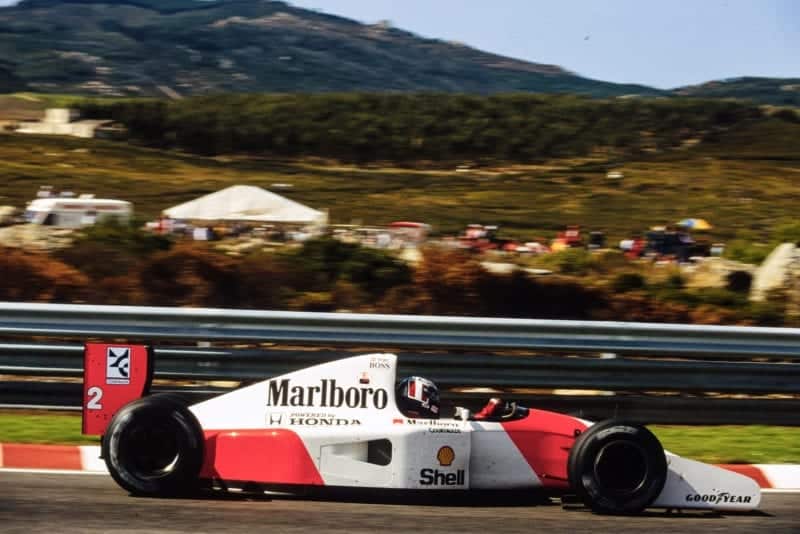
Gerhard Berger in the McLaren
Motorsport Images
The Williams’ left rear wheel touched down first, which initiated a restorative moment that brought the nose smacking back down, and as it shed its right-hand wheels against the pit wall the tattered FW14B slithered down to the Ferrari pit before its momentum was finally expended. Shaken, Riccardo stepped out and hobbled to safety.
The incident raised some serious questions over pit wall safety, for this is the fourth time in the past five years that a car has nearly injured team personnel. Remember Alliot’s shunt in Mexico, or Capelli’s in Detroit in 1988? Gugelmin’s Wall of Death in the rain in Adelaide last year?
It also raised questions over tactics concerning planned pit stops. Back in 1985 at Zandvoort Thierry Boutsen had had a nasty experience when Rene Arnoux pulled in without warning in his Ferrari and launched the Belgian’s Arrows. After his shunt, Patrese demanded action from the stewards, who took the extraordinary view that it was simply a misunderstanding about which they could do nothing. Berger was contrite afterwards, but echoed their sentiments. Riccardo fumed. Nobody suggested for a moment that what Berger did was deliberate, but it was certainly unthinking. He knew he was going to come in for another set of tyres, something that, since they had already both stopped for that purpose, Riccardo had no reason to expect.
That incident put in a nutshell the Portuguese GP, and to an extent the current state of F1 . There was a lot of chasing in Portugal, but not much racing, not much overtaking. Behind the two Williamses and the two McLarens initially, Hakkinen starred ahead of Brundle’s Benetton after the latter’s team-mate Schumacher had had to start from the pit lane after his engine cut out on the formation lap. Behind them once Alesi had eliminated Herbert on the first lap and then himself with a spin in his ill-handling Ferrari on lap 13, Alboreto had run a lonely seventh, clear of a frantic scrap between Gachot, the Ligiers of Boutsen and Comas, de Cesaris, Grouillard, Lehto and Capelli. One by one some fell out, Gachot with low fuel pressure, Grouillard with gearbox problems and CapeIli with a down-on-power Ferrari V12. It was a telling indication, however, that having sliced through the field to 13th place by lap six even a talent such as Schumacher then found it very difficult to make further progress as he bogged down behind Comas. The straight is the best place to try and pass at Estoril, but if your rival has better top speed you can be stymied no matter how much better your car is everywhere else. This has often been true throughout the various GP eras, but never has it been more noticeable than it is today.
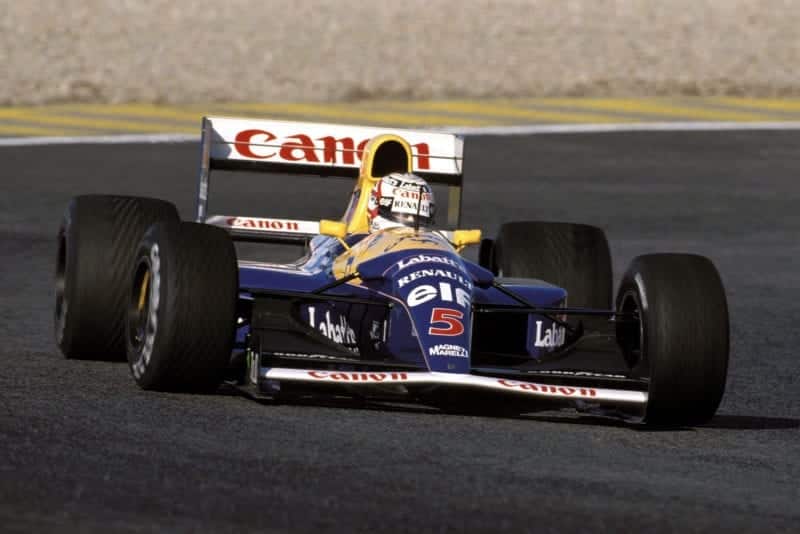
Nigel Mansell focused as he closes in on race victory
Motorsport Images
It was all a case of What Might Happen, rather than What Is Happening, and it took something like Patrese’s accident to snap spectators from their stupor. Surely something is wrong with F1 if it takes an incident to raise the level of excitement. Whatever happened to passing and repassing?
Somebody had clearly omitted to tell the script to Mika Hakkinen. With Schumacher’s grid slot vacant the Finn made full use of the empty gap and his own personal best F1 grid position to jump into fifth place at the start, and in the opening stages he was far from overshadowed by the McLarens. As Brundle lagged in sixth and Senna eased away from his teammate, Berger came under attack from the rapid Lotus driver. For a few laps it seemed he might even be deprived of fourth place, but the McLaren was always very quick down the straight and Hakkinen wisely accepted that a long race is not always won at the first corner. Later, as he and Brundle came up to lap the Lehto, Martini, Wendlinger battle for 13th place Pierluigi was in uncharacteristically selfish form and steadfastly refused to give way. Mika was already nursing a fourth gear that had taken a liking to jumping out of engagement, and Brundle jumped him in traffic on the 34th lap. That should have been the end of it, but Hakkinen had a re-write of the normal script and repassed the Benetton after four laps in sixth place. By that time they were finally clear of this little group, though, and Brundle was able to make a passing move stick on lap 44 and thereafter pulled away as Hakkinen looked after his transmission problem.
That, bar a frantic little battle between Naspetti and Fittipaldi for 11th place in the closing laps, was the final excitement in a dull affair. Senna, whose greatest drama had come with rear wing collapse during qualifying, stopped three times in total and made it through on four sets of Goodyears, complaining of a peculiar chassis imbalance that made the McLaren feel like a three-wheeler even on the straights. It says a lot about the kind of race it was that he still finished third.
In fact, for most of the weekend the on-track action was thoroughly overshadowed by the rampant politicking that characterised the meeting. If it wasn’t a game of spotting who was locked away in the Williams motorhome this time and there were visits from Prost, Senna (prolonged), Benetton’s Flavio Briatore and Lotus’s Peter Collins then you couldn’t fail to hear the screams of the injured egos. Senna’s was the worst hurt, as he discovered finally on Sunday morning that Prost was going to be Williams’ number one for 1993. Still he would not accept defeat, and launched into another tirade in which the word coward sprang to his lips to describe his detested nemesis.
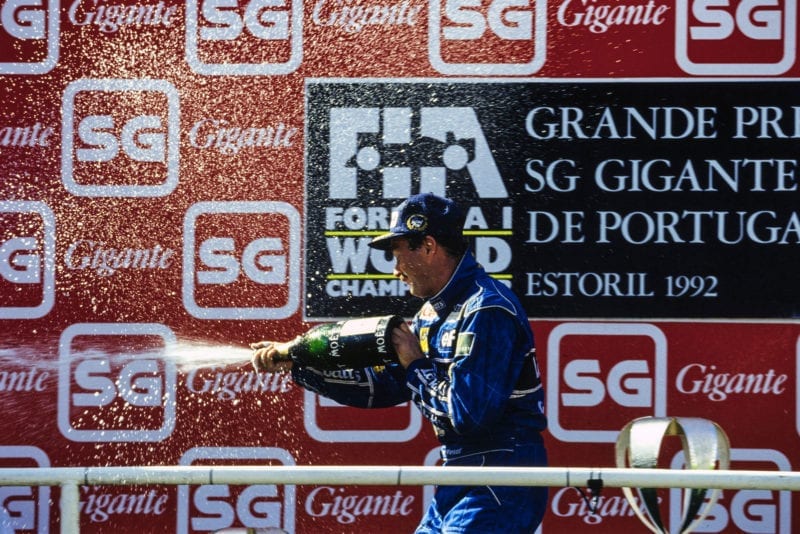
Mansell sprays the champagne after a deserved win
Motorsport Images
Through it all, Mansell savoured a well-won victory and no doubt watched it all with wry amusement. Over breakfast the previous Thursday he had explained how he felt. “You know, when you really, really want something, it hurts. But when you decide that you don’t want that something any more, the hurt goes away and you feel a profound sense of relief. That’s how I honestly feel since making my decision. I wanted the World Championship and I won it. I wanted to defend it with Williams, but now I can’t. But instead, I can let all the aggravation go over my head now.”
In Estoril that wasn’t such a bad idea. And neither, it seemed at times, was the thought of a switch to lndycars…
Portuguese Grand Prix, Estoril, September 27
71 laps of 2.703-mile (4.350 km) circuit (191.910 miles; 308.848km)
1. Nigel Mansell – Williams FW14B-Renault V10 – 1h 34m 46.659s
2. Gerhard Berger – McLaren MP4/7A-Honda V12 – 1h 35m 24.192s
3. Ayrton Senna – McLaren MP4/7A-Honda V12 – 70 laps
4. Martin Brundle – Benetton B192-Ford-HB V8 – 70 laps
5. Mika Hakkinen – Lotus 107-Ford-HB V8 – 70 laps
6. Michele Alboreto – Footwork FA13-Mugen V10 – 70 laps
